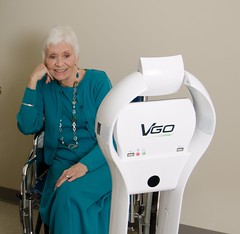VGo to Work with Nurses in Patients' Homes
Visiting Nurse and Hospice of Vermont and New Hampshire announced its agreement with VGo which will enable four remotely-driven robots to be deployed for patient assistance
July 25, 2012 | By KIMBERLY HOUGHTON, Union Leader Correspondent
NASHUA— VGo Communications Inc. is teaming with an area health-care organization to offer New Hampshire’s first telepresence robots to patients.
Visiting Nurse and Hospice of Vermont and New Hampshire announced its agreement with the local company Wednesday, which will enable four remotely-driven robots to be deployed for patient assistance.
“We are the first in the region to try something like this. It is pretty groundbreaking,” said Craig Amoth, spokesman for VNAVNH.
Amoth stressed that the portable VGo robots will not replace nurses, but rather allow patients access to multiple professionals and experts in addition to a visiting nurse.
Mobile consulting
A four-wheel robot will be able to travel to patients’ homes with nurses, and with the use of advanced technology, it will enable other health-care workers to provide consultations and support from another location using WiFi.
“We are on the true leading edge of this. We believe the robotic telepresence will have significant impact on patient outcomes and staff,” said Amoth, explaining that specialists and consultants can be available to share their expertise without having to spend an hour on the road traveling to remote locations in New Hampshire or Vermont.
VGo Communications, housed at 100 Innovative Way, develops and markets visual communications solutions for hospitals, homes, schools and the workplace. Its new telepresence robot, which was launched about a year ago, has since been featured by several national media outlets, specifically for its capability of allowing sick children to still attend school using technological advancements. The company was named one of five finalists for the 2010 Product of the Year Award by the New Hampshire High Technology Council.
“VNAVNH’s visionary approach to improving health care at home is a perfect match with our goals of replicating a person in a distant location at a very affordable cost,” said Peter N. Vicars, CEO of VGo, in a statement. “For about $10 a day, their nurses can visit more clients, spending more time with each one and less time on the road.
“Researchers have proven that patients enjoy interacting with their caregivers using VGo and look forward to each visit.”
Although four robotic units are about to be deployed, Amoth is optimistic the trial period will be successful and that more robots may eventually be utilized.
Future uses
Initially, the robots will only be used while a nurse is visiting with a patient, but Amoth said it is conceivable that in the future, the robot units may be able to stay with patients when nurses are not present.
“We are continuously looking for ways to increase levels of care, independence and safety in the home. VGo is the first affordable solution that enables us to expand client engagement without a dramatic increase in cost, while still preserving a person-to-person interaction,” Jeanne A. McLaughlin, president and CEO of VNAVNH, said in a press release. “People often need more care and attention, not less, but that’s hard to do in rural areas without an army of staff.”
Frequent visits
According to McLaughlin, VGo’s lightweight and ease of deployment means that nurses and doctors can now visit with select patients more frequently.
By eliminating the need to travel for each visit, McLaughlin said that professional staff can better utilize their time and respond to client needs and unforeseen problems that arise much quicker.
For instance, Amoth explained that if a client is having a complication with a wound that doesn’t seem to be healing properly, the visiting nurse can use the robotic telepresence to speak with a wound-care specialist elsewhere, show them live and up-close video footage of the wound and receive immediate medical advice.
“This is very exciting to have (the robots) deployed here in New Hampshire,” said Ned Semonite, vice president of marketing for VGo. “We do think in time that this will be something that is common, in the same way that people use Skype today. People will have instant access to medical experts.”
Semonite said the robot is user friendly and requires no setup, adding that clients — including elderly patients — are receptive to the modern concept. VGo robots cost about $6,000 to purchase, along with an annual service contract of about $1,200.
